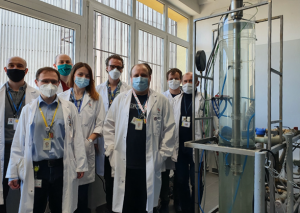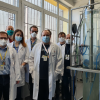The new research equipment for HTGR undergoes the first tests in the MARIA reactor
2021.06.29 15:05 - udgov_hsScientists from the NCBJ Reactor Research Department have designed a probe that allows samples to be irradiated at a temperature of over 1000 degrees, which is under the conditions prevailing in HTGR reactors. The first tests in the MARIA reactor turned out to be very promising.
HTGR (High-Temperature Gas Reactors) are considered worldwide as one of the promising options among various new generation reactor technologies. They can produce heat at a temperature sufficient for industrial, chemical or green hydrogen applications by high-temperature distillation of water. Research on this technology is currently carried out by, among others, Japan, China and the Polish National Center for Nuclear Research.
A reactor probe is a device that allows irradiation of material samples, a component or its part under strictly defined conditions, e.g. temperature, pressure, inert gas atmosphere, etc. The ISTHAR probe (Irradiation System for High-Temperature Reactors) allows irradiation of material samples in the MARIA reactor under conditions corresponding to prevailing in high-temperature gas reactors: temperature up to 1000 ° C and helium atmosphere. The MARIA research reactor has a neutron flux that is many times greater than that of energy reactors, which makes it possible to perform the study in a very short time. Maciej Lipka from the Reactor Research Department explains: “Research MARIA has about 25 times greater neutron flux than HTGR reactors, thanks to which we can observe the damage that occurs in materials during many decades of nuclear power plant operation much faster. This allows for a significant acceleration of work while ensuring the highest quality of the experiment. "
The device was entirely designed at the NCBJ Nuclear Facilities Operation Department as part of the GOSPOSTRATEG project. The first tests using a specially designed model of the irradiation channel of the MARIA reactor turned out very favorably - scientists managed to achieve a stable operating temperature of over 1000 ° C and very homogeneous conditions inside the probe. "At the same time, outside, on the wall surrounded by water, the temperature is only a few dozen degrees Celsius - the insulation is provided by only 3 millimeters of helium, but this thickness is completely sufficient." - specifies M.Sc. Anna Talarowska also from the NCBJ Reactor Research Department. The whole thing is closed in a steel capsule cooled from the outside with water flowing in the gap of the beryllium matrix of the MARIA reactor. "The development of the probe is a multi-stage process that starts with computer simulations and calculations, then the technologies and technical design are developed along with the implementation procedures, and the mentioned experiments in the reactor or dedicated mock-ups are the culmination of the work and confirmation of the initial predictions."
Devices similar to ISHTAR, allowing the irradiation of samples under strictly defined temperature conditions, were already used in MARIA in the distant past, but due to the negligible interest in nuclear power development programs, they were not built since the 1980s. Currently, three probe programs are underway to study not only materials used in classic reactors, but also those used in thermonuclear fusion. The ISTHAR probe is the first to be built from scratch by a rejuvenated team. There are plans for the next stages of research aimed at the development of new energy reactor technologies: both nuclear and thermonuclear. It is planned, inter alia, to irradiate, also in proprietary probes, elements of the DONES device and tests of components for the ITER fusion reactor.


















